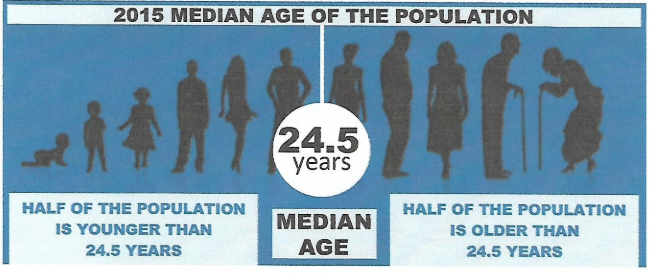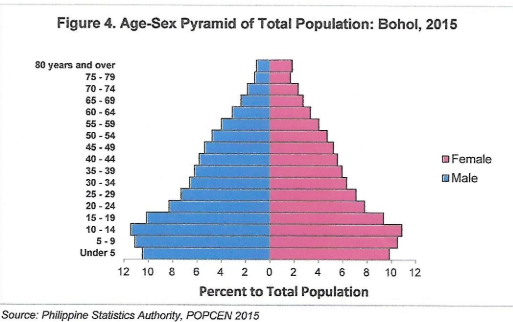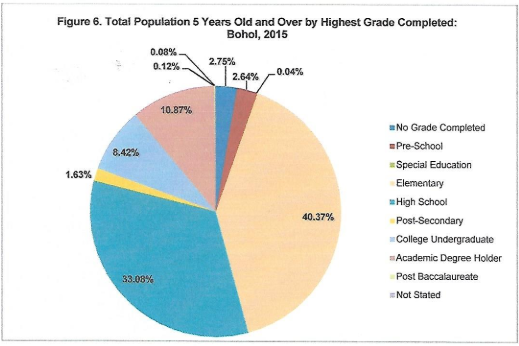
Total population rose by more than 50,000 persons from 2010 to 2015
Based on the results of the 2015 Census of Population (POPCEN 2015), the total population of Bohol was 1,313,560 as of August 1, 2015.
This population count is higher by 58,432 persons than that of the 2010 population and by 147,430 persons than that of the 2000 censal year.
On a regional scale, out of the 6,041,903 population of Central Visayas, 21.7% belonged to Bohol and ranked second in terms of population among the three provinces and three highly-urbanized cities.

Tagbilaran City topped in terms of total population
The capital city of Bohol had a total population of 105,051 as of August 1, 2015. However, this covers only 8% of the total population of the province.
Among the 47 municipalities, Ubay, Talibon and Carmen were the top three most populous with population of 73,712, 66,969 and 46,306, respectively.
The combined population of the top 10 populous municipalities in Bohol accounted for about 41% of the total population province-wide.

On the other hand, the least populous municipality of Bohol is Sikatuna with only 6,726 persons listed.
Other municipalities with less than 10,000 populations were Corella and San Isidro.

There were 103 males for every 100 females
In Bohol, there were more males than females. Male population accounted for 50.8% of the total population.
This resulted to a sex ratio of 103 for the province.
Among the municipalities, Buenavista had the highest sex ratio of 108 while Tagbilaran City had the lowest sex ratio of 98.
Median age increased to 24.5 years
From 23.7 in 2010, Median age for Boholanos rose to 24.5 years old. This means that half of the total population was below 24.5 years old.


The number of households increased by more than 27,000
From 261,408 households in 2010, the number of households in Bohol rose to 288,515 after five years that resulted to a 10.4 percent increase.
On the contrary, the average household size decreased from 4.79 in 2010 to 4.5 in 2015.

The largest age group was 10 to 14 years old
Figure 4 shows that the age group that comprised the highest percentage of the population was 10-14 years old. This was followed by the age group 5 to 9 years old (10.8%) and 0 to 4 years old (10.2%)
There were more males than females belonging to ages 55 years old and below. More females were noted starting at the age group than 59 years old.
Overall dependency ratio decreased to 65 dependents per 100 persons in the working-age group
In 2015, sixty percent of the total population belonged to the working-age population. Children below 15 years of age and those aged 65 years and over comprised 32.1 and 7.5 percent, respectively.
With this, the overall dependency ratio of Bohol was 65 dependents for every 100 persons in the working age group, lower by four persons compared to that of 2010. Of the 66 dependents, 53 were young dependents while 12 were old dependents.
Sixty two percent of the total population was of voting age
Out of the total population of the province, 810,417 (62%) belonged to the voting-age population.

Females outnumbered males in four types of marital status
A large portion of the total population of those aged 10 Years old and over was single, that is, 44.1%. Following was those who were married that took up 42.8%.
More females were noted among the married, widowed, divorced/separated and common-law/live in. Furthermore, among the widowed, seventy six percent were females.
Four out of ten Boholanos aged 5 years old and over had attended or completed elementary education
The largest fraction of the pie belonged to those who attended or completed elementary education. This was followed by those who went to or attained high school.
On the other hand, only 10.87% were academic degree holders and 0.12% was able to finish post baccalaureate degrees.
School attendance rate was higher among females than among males
The household population aged 5 to 24 years old was 519,497. Out of this, 73.7 percent was attending school in School Year (SY) 2015-2016.
Moreover, the school attendance rate among females was 75.0 percent whereas among males was 72.6 percent.
Simple literacy rate was recorded at 98.3 percent
A literacy rate of 98.3 percent was recorded among the household population aged 10 years and over. Simple literacy means that a person is able to read and write a simple message in any language or dialect.
By sex, literacy rate in was slightly higher among females (98.5 percent) than among males (98.2 percent).
Nine out of ten Boholanos were Roman Catholics
Roman Catholics dominated Bohol, accounting for 90.6 percent of the total population.
Other Religious Affiliations and UCCP followed in rank with 1.73 and 1.14 percentages, respectively. The rest of the population was divided among the other religious affiliations, most of which having counts that were less than one percent.
More than half a million were engaged in a gainful activity
A total of 526,018 persons 15 years old and over were engaged in a gainful activity (40.2 percent).
The top three largest major occupation groups were skilled agricultural, forestry, and fishery workers (27.1 percent of all persons with gainful activity), elementary occupations (20.0 percent) and, service and sales workers (14.4 percent).

Only 3.5 percent of the household population worked abroad
Overseas workers comprised only 3.5 percent of the household population 15 years old and over. Of the 31,621 OWs, about two fifths were aged 25-34 years old.
Sgd. JOCELYN S. SARMIENTO
Supervising Statistical Specialist
OIC-Provincial Statistics Officer
TECHNICAL NOTES
The 2015 Census of Population (POPCEN 2015) was undertaken by the Philippine Statistics Authority (PSA) in August 2015 as mandated by Republic Act No. 10625, otherwise known as the Philippine Statistics Act of 2013. It was the 14th census of population that was undertaken since the first census in 1903. POPCEN 2015 was designed to take an inventory of the total population all over the Philippines and collect information about their characteristics. Census day for the POPCEN 2015 was August 1, 2015 (12:01 a.m.). POPCEN 2015 made use of the de jure concept of enumeration wherein households and persons are enumerated in the area where they usually reside as of the census reference date. Enumeration lasted for about 25 days from 10 August to 6 September 2015. Enumeration was extended until 15 September 2016 for large provinces and some highly urbanized cities. |

